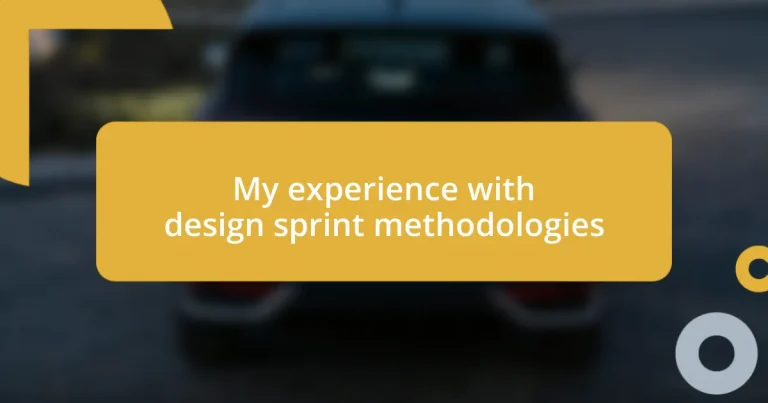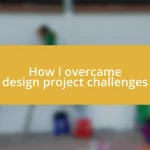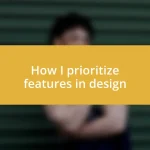Key takeaways:
- Design sprints consist of five phases: Understand, Sketch, Decide, Prototype, and Test, each contributing to a collaborative and productive environment.
- Key benefits include streamlined decision-making, user validation, and fostering a culture of innovation and experimentation among team members.
- Challenges such as time constraints and team dynamics can be addressed through clear goal-setting, open communication, and regular feedback loops.
- Design sprints encourage continuous growth and adaptation, emphasizing the importance of experimenting within tight timeframes for effective outcomes.
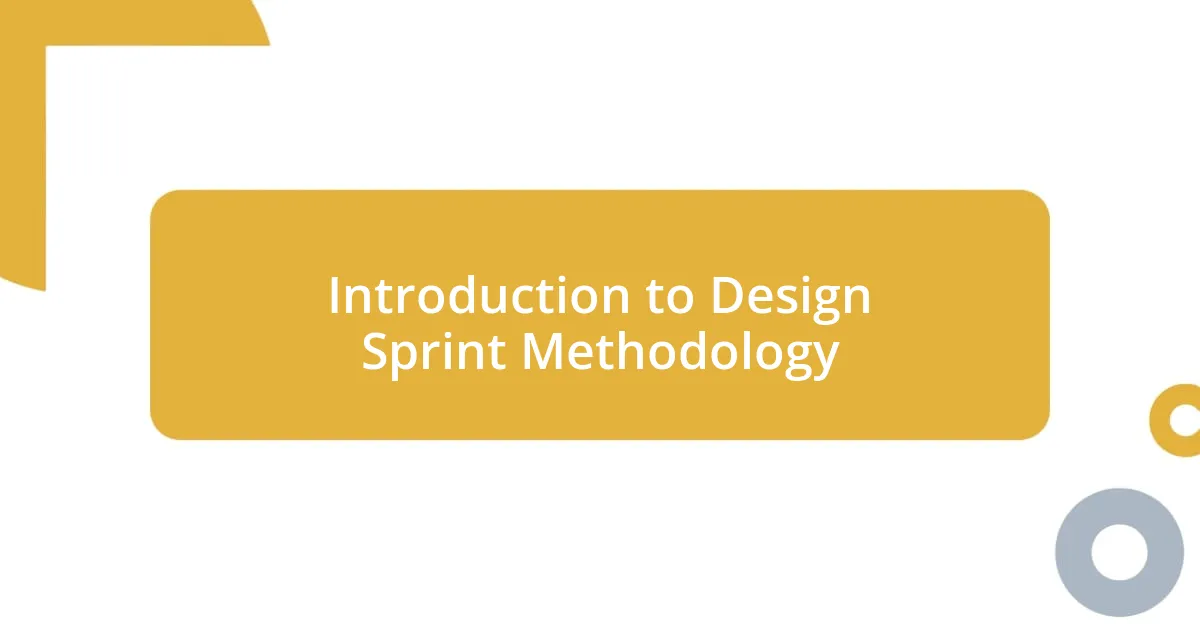
Introduction to Design Sprint Methodology
Design sprints are powerful tools that bridge the gap between ideas and execution in just five days. I remember my first encounter with this methodology; we were grappling with a massive project, and the thought of jamming everything into a single week was both exhilarating and terrifying. Have you ever felt stuck wondering how to turn a brilliant concept into reality? That’s where design sprints come into play.
This methodology focuses on rapid prototyping and user testing, which can feel like a breath of fresh air in a world where projects often drag on for months. The intensity of a design sprint pulled me out of my comfort zone, making me realize how much I valued collaboration and swift decision-making. It’s almost like a high-stakes game where each day counts, and the stakes are tangible.
During my first sprint, the energy was palpable; it ignited a spark within me. We combined diverse perspectives, which revealed solutions I never dreamed were possible. Have you ever experienced that “aha” moment when pieces just fall into place? That’s the magic of a design sprint—it encourages creativity while honing in on what truly matters for the project at hand.
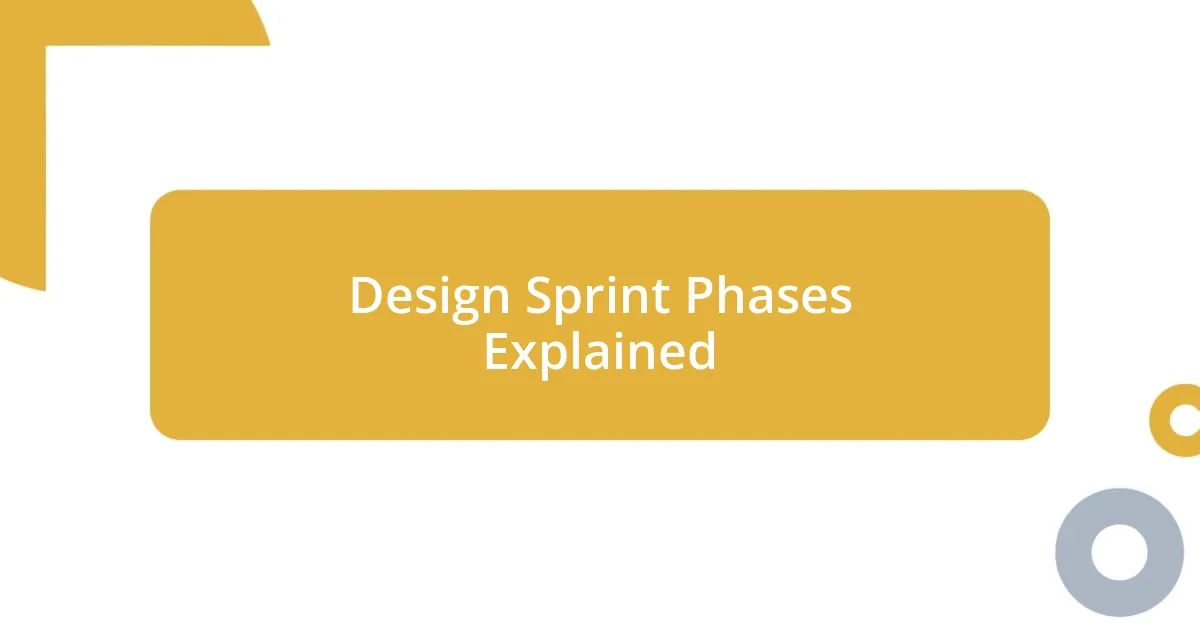
Design Sprint Phases Explained
The design sprint methodology consists of five distinct phases, each designed to maximize productivity and creativity. I remember feeling a mix of excitement and pressure as we dashed through these phases. It’s fascinating how each day builds on the last, leading to a tangible outcome.
Here’s a quick breakdown of the design sprint phases:
- Understand: We start by defining the problem and establishing goals. I still recall those initial discussions, where we identified crucial pain points—it really set the stage for our work.
- Sketch: Next comes the sketching phase, where we generate a plethora of ideas. I was amazed at how drawing concepts made our abstract thoughts more concrete, pushing us out of our comfort zones.
- Decide: After generating ideas, we collectively narrowed them down to the most promising ones. That voting process was exhilarating; you could feel the energy shift in the room!
- Prototype: This is where we transformed our best ideas into tangible prototypes. I can vividly recall the adrenaline rush as we hurried to create something we could test by the end of the week.
- Test: Finally, we put our prototypes in front of real users. The feedback we gathered was invaluable and made the long hours worth it; seeing users interact with our designs offered insights that were eye-opening.
Each phase has its unique rhythm and contributes to the overall success of the sprint, making it a powerful experience that sticks with you long after the final day.
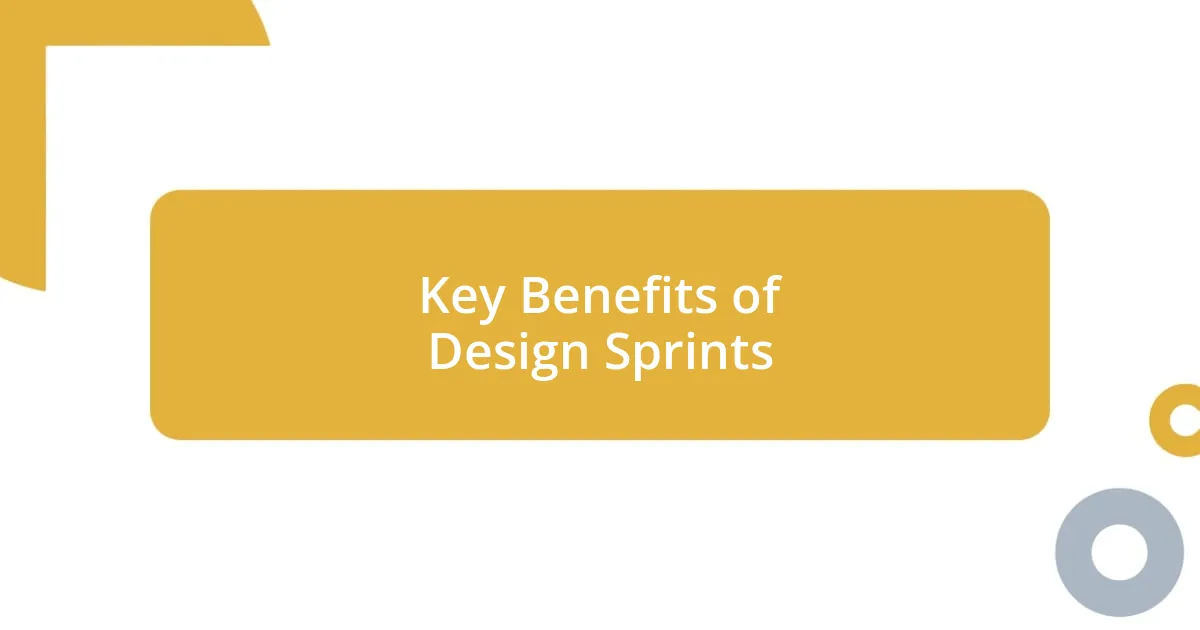
Key Benefits of Design Sprints
The most significant benefit of design sprints is how they streamline the decision-making process. I’ve often found that when collaborating as a team, reaching consensus can take ages. During one of my sprints, we had to choose between two competing ideas. Instead of lengthy debates, we quickly voted and discussed each concept’s merits. That focused discussion not only saved us time but also revealed a collective energy that drove us toward our goal with clarity.
Another key benefit is the ability to validate ideas before investing heavily in development. I remember a particular sprint where we tested a new feature concept with real users. Getting immediate feedback was exhilarating; it felt like holding up a mirror to our design. Instead of relying on assumptions, we had concrete insights that colored our next steps. This element of user involvement not only boosted team morale but also ensured our product would genuinely resonate with users.
Design sprints also create a culture of experimentation and innovation within teams. I’ve noticed that the intensity and time constraints encourage a mindset where failure becomes an integral part of the learning process. It’s liberating to know that not every idea needs to work perfectly the first time. In one sprint, we brainstormed wild ideas that seemed outrageous, but it was those very concepts that led to unexpected breakthroughs. The energy in the room was electric, reminding me that sometimes, playing outside the lines leads to the most innovative solutions.
| Benefit | Description |
|---|---|
| Streamlined Decision-Making | Facilitates quick consensus and reduces prolonged discussions. |
| User Validation | Enables testing of ideas with real users for immediate feedback. |
| Culture of Innovation | Encourages experimentation and acceptance of failure as part of the creative process. |
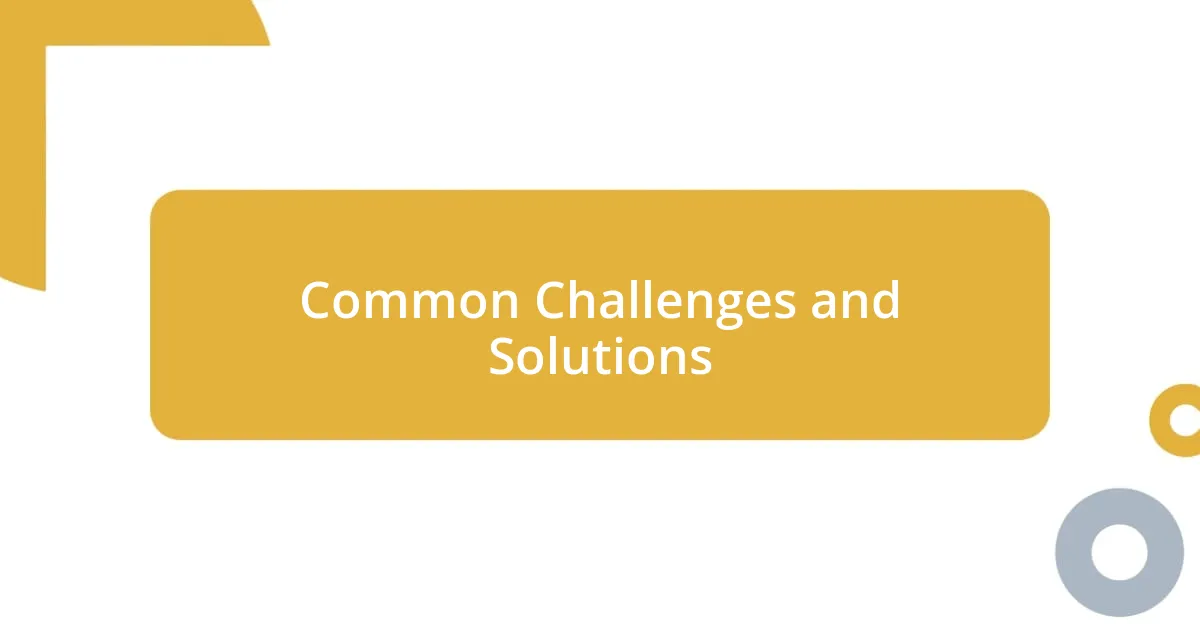
Common Challenges and Solutions
One common challenge I faced during design sprints was managing time constraints. It can be daunting to fit so many critical tasks into such a short time frame. I vividly remember a sprint where we had to rush through prototyping. It felt like walking a tightrope between speed and quality. But we learned that assigning specific roles and breaking tasks into smaller chunks helped us stay focused and productive, even when the clock was ticking down.
Another issue often arises with team dynamics. Sometimes, not all voices are heard, leading to the risk of overshadowed ideas. I’ve been in situations where quieter team members hesitated to share their thoughts, thinking their opinions weren’t valued. Realizing this, we started having quick “check-in” moments during each phase. This practice encouraged everyone to contribute, leading to richer discussions and a more inclusive atmosphere. Isn’t it fascinating how a simple shift can bring out the best in a team?
Lastly, iterating too quickly can often sabotage the sprint’s effectiveness. I remember feeling a rush to move on to testing just to check off the box, which almost backfired when we presented a prototype that wasn’t fully polished. It was a lesson learned; taking a moment to pause and refine our work led to a significant improvement in user feedback. Continuous reflection and iteration became our mantra, reminding us that quality often trumps speed in the pursuit of impactful design.
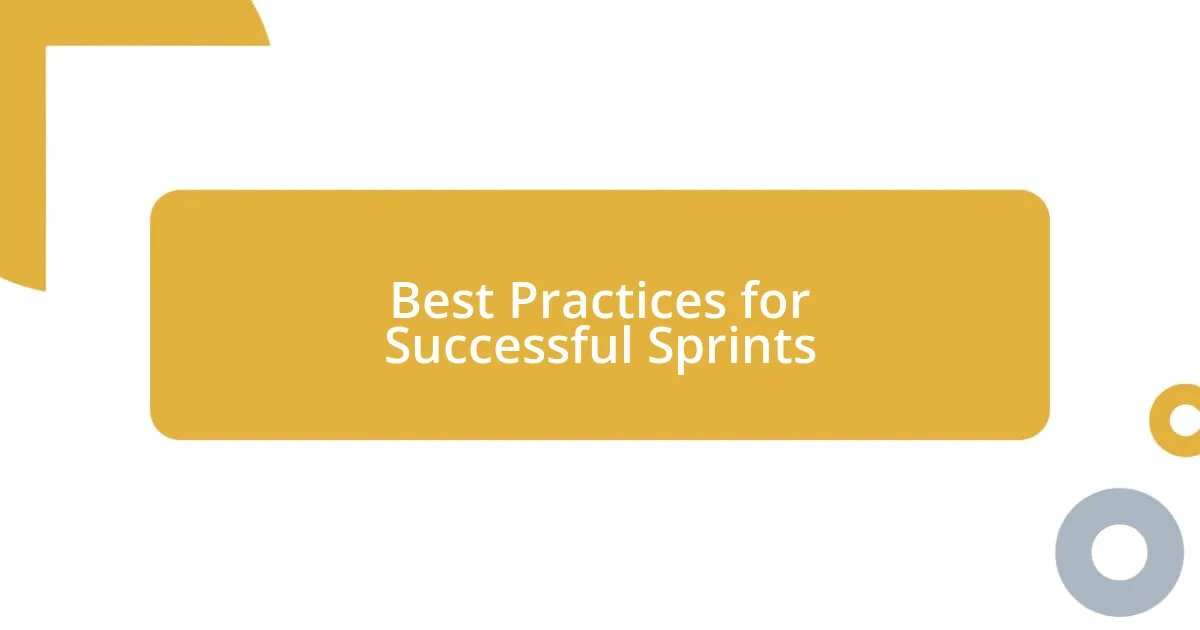
Best Practices for Successful Sprints
When it comes to successful design sprints, setting clear goals is crucial. I recall one sprint where we started without a well-defined objective, and it felt like we were wandering through a maze. The moment we refined our focus, it was as if a light bulb went on—the team aligned effortlessly, and our discussions gained depth and purpose. How often have you found that clarity transforms group efforts? It’s an essential first step.
Another best practice is fostering an environment of open communication. During one sprint, we implemented a “no idea is too crazy” rule, which opened the floodgates for creativity. It was thrilling to witness team members share even their wildest thoughts without fear of judgment. The atmosphere transformed, and we ended up with concepts that truly pushed boundaries. Creating space for everyone to express themselves isn’t just beneficial; it can be the key to unlocking innovative solutions.
Lastly, embracing feedback loops should never be overlooked. I once participated in a sprint where we didn’t include follow-up sessions for feedback after testing out our prototypes. The resulting oversight stung; we missed out on valuable insights that could have guided our next iterations. Including opportunities for both giving and receiving feedback ensures that lessons learned during the sprint are carried forward, creating a continuous cycle of improvement. Isn’t it amazing how a commitment to communication can elevate a team’s work?
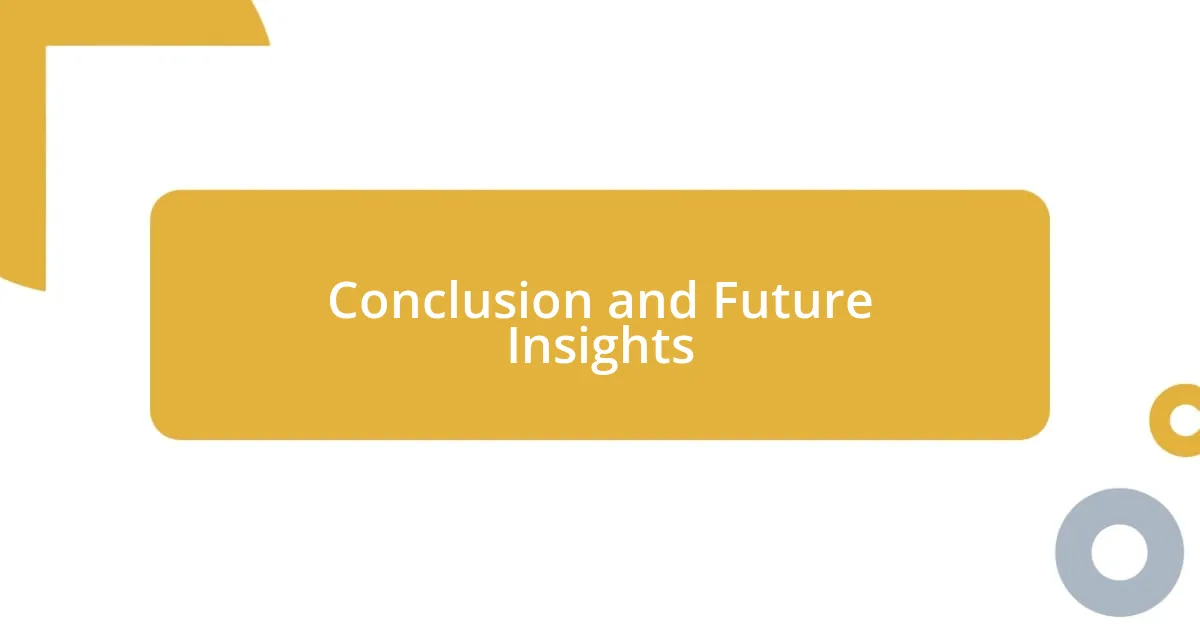
Conclusion and Future Insights
Reflecting on my experience with design sprints, I realize that every challenge has been a stepping stone. There’s something profoundly rewarding about seeing a concept evolve from mere sketches to tangible prototypes in just a few days. It makes me wonder—how often do we give ourselves permission to experiment and learn in such a compressed timeframe? The lessons learned during sprints not only refined my skills but also deepened my appreciation for collective creativity.
As I look to the future, I’m excited about the potential for design sprint methodologies to evolve even further. Imagine integrating diverse perspectives from remote teams with innovative tools that streamline collaboration. I can’t help but think about how these advancements could enhance inclusivity and creative problem-solving. Doesn’t it spark curiosity to think how our processes can continue to adapt in an ever-changing landscape?
In conclusion, I believe that the journey through design sprints is one of continuous growth and adaptation. Each sprint offers a chance to refine not just our designs, but also our collaborative practices. It’s a bit like cultivating a garden—the more we tend to it, the more vibrant and fruitful it becomes. What insights will your next design sprint yield?












